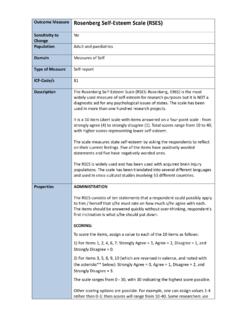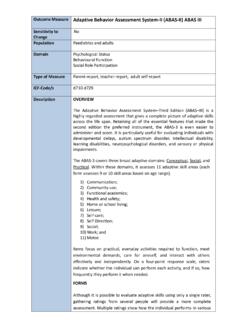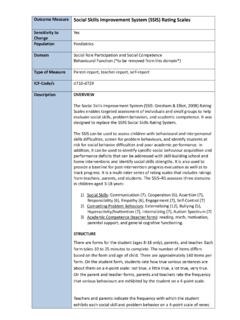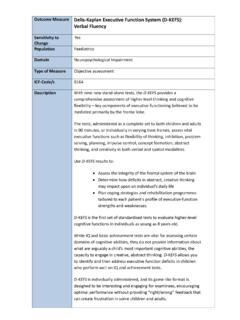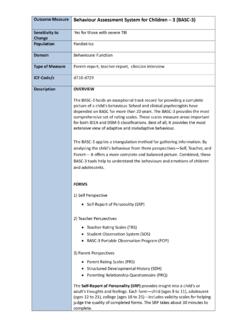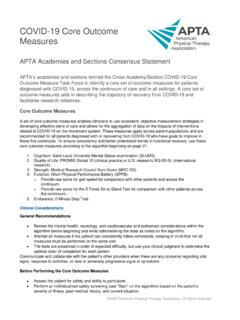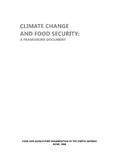Transcription of Western Aphasia Battery-Revised; Aphasia Quotient (TBI ...
1 outcome Measure Western Aphasia Battery-Revised; Aphasia Quotient (TBI Bank Protocol). Sensitivity to Yes Change Population Adult Domain Language and Communication Type of Measure Objective test ICF-Code/s b1. Description Western Aphasia Battery Revised (WAB R; Kertesz, 2007), Aphasia Quotient , is a composite score that provides an overall measure of severity, in which lower scores denote more severe Aphasia (a score > is considered to be within normal limits). The battery forms part of the TBI. Bank Protocol. The Western Aphasia Battery or WAB is a criterion and standardized test intended to determine the presence, severity and type of Aphasia . The WAB R, a full battery of 8 subtests (32 short tasks).
2 They include: (1) Spontaneous Speech (part 1): Conversational Question and Picture Description (2) Auditory Verbal Comprehension (part 1): Yes/No Questions, Auditory Word Recognition, Sequential Commands (3) Repetition (part 1). (4) Naming and Word Finding (part 1): Object Naming, Word Fluency, Sentence Completion, Responsive Speech (5) Reading (part 2): Comprehension of Sentences, Reading Commands, Written Word-Object Choice Matching, Picture- Written Word-Object Choice Matching, Spoken Word-Written Word Choice Matching, Letter Discrimination, Spelled Word Recognition, Spelling (6) Writing (part 2): Writing Upon Request, Writing Output, Writing to Dictation, Writing Dictated Words, Alphabet and Numbers, Dictated Letters and Numbers, Copying a Sentence (7) Apraxia (part 2).
3 (8) Constructional, Visuospatial, and Calculation Tasks (part 2): Drawing, Block Design, Calculations, Raven's Coloured Progressive Matrices Only the first 4 subtests contribute to the Aphasia Quotient . The WAB also contains supplemental Writing and Reading Tasks: Writing Irregular Words to Dictation, Writing Non-Words to Dictation, Reading Irregular Words, Reading Non-Words (Supplemental). The WAB takes approximately 45. mins to administer. Properties See Kertesz (2007) and TBI Bank website: Internal consistency (.91), intra-rater and inter-rater reliability, and test- retest reliability are all high. Correlations between the WAB-R and Neurosensory Centre Comprehensive Examination for Aphasia are highly associated (.)
4 96). Advantages Catches Aphasia in the % of people that have it and may be used earlier in recovery Widely known Appropriate for Aphasia and low level cognitive communication difficulties Aphasia Quotient is a useful way of determining the type of Aphasia which can assist with developing impairment based goals Useful for pre and post assessment. Two separate forms for auditory skills vs reading skills Ease of administration & scoring across levels of experience; eas of use All the instructions are on the form and there is no need to switch between forms and the manual Good accessibility & availability Disadvantages Assesses basic language function & not higher level No data for TBI. Many people with TBI would perform greater than or close.
5 Ceiling effect Difficult maintaining objects required for assessment Not considered appropriate for cognitive communication skills. Can be overused and used inappropriately. Additional A review of speech-language pathology assessments deemed the WAB as appropriate for standardised assessment with people with TBI when the Information test's goals, structure, and standardisation sample matches the needs of the clinician and the characteristics of the individual with the cognitive- communication disorder (Turkstra & Coelho & Ylvisaker 2005). Reviewers Leanne Togher References Turkstra L, Coelho C, Ylvisaker M. The use of standardized tests for individuals with cognitive- communication disorders.
6 Semin Speech Lang 2005;26: 215 222.

